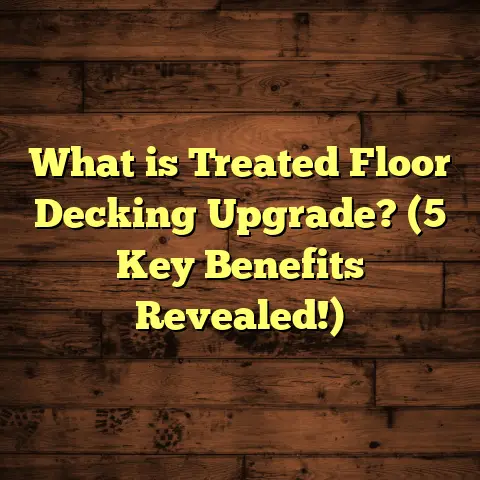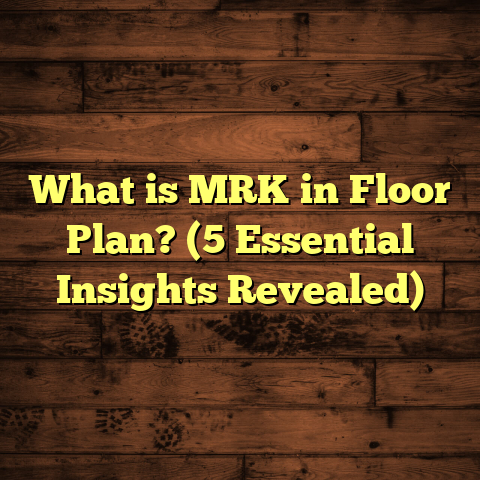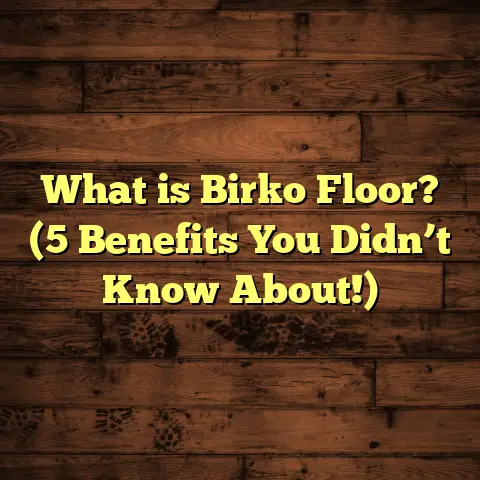What is Parquet Flooring? (5 Reasons to Upgrade Your Home)
Regional Needs Shape Flooring Choices
When I first started working as a flooring contractor, I quickly realized that not all floors are created equal—what works in one region just doesn’t cut it in another. This is something many homeowners overlook when picking their floors.
Take humidity, for instance. In the deep South, where the air feels thick and sticky most of the year, certain wood floors swell or warp easily. Meanwhile, up in the Northern states where freezing temperatures and snow are common, floors need to stand up to temperature swings and fluctuating moisture levels without cracking or separating.
My clients in coastal regions often want floors that can withstand salty air and occasional wetness, while those living in dry mountain areas prioritize floors that don’t dry out and crack.
That’s why I always tailor my flooring recommendations to the local environment. Parquet flooring has become one of my favorite options because it handles these challenges well, and it adds so much character to a home.
What is Parquet Flooring?
You might wonder, “What exactly is parquet flooring?” Simply put, parquet is a style of wood flooring that uses small pieces of hardwood arranged in decorative patterns. These aren’t your standard long planks laid side by side. Instead, parquet is like a mosaic, creating shapes such as squares, triangles, herringbone (zig-zag), or chevron (V-shapes).
The word “parquet” comes from the French word parchet, meaning “a small enclosed space.” Its history goes back centuries. In the 17th century, French craftsmen used parquet floors to replace marble flooring in royal palaces because marble was slippery and hard to maintain. This switch was not just practical but also elegant.
What I find fascinating is how parquet combines artistry with functionality. Each tiny wood piece is carefully cut and arranged to form a pattern that can be simple or intricate. It’s like having art beneath your feet.
My Experience Installing Parquet
Let me tell you about one memorable project. A client in upstate New York wanted to restore the historic charm of their 1920s home. We decided on a Versailles parquet pattern—a classic French design with interlocking geometric shapes made from oak and walnut.
The process was meticulous. Each piece had to fit perfectly. It took more time than regular hardwood installation, but seeing the finished floor light up the room was worth every hour.
What stood out to me was how the parquet floor adapted to the harsh winter climate. Because it’s made of smaller pieces glued on a stable substrate, it resisted the expansion and contraction caused by temperature swings much better than traditional hardwood.
5 Reasons to Upgrade Your Home with Parquet Flooring
1. Timeless Style That Adds Character
Have you ever stepped into a space and felt instantly charmed by the floor? Parquet has that effect on people. Unlike plain hardwood floors, its patterned layout brings depth and texture, making any room feel warm and inviting.
According to the 2023 National Wood Flooring Association report, homes with parquet flooring have an average resale value increase of about 12% compared to homes with standard hardwood. Buyers love the uniqueness and craftsmanship it signals.
I’ve noticed clients gravitate toward patterns like herringbone for its classic zig-zag effect or basketweave for a more subtle woven look. These patterns don’t go out of style—they’re like a legacy you pass down through generations.
One client told me their parquet floor became a conversation starter at every gathering, with guests admiring the detail and beauty beneath their feet.
2. Better Durability and Maintenance
Parquet isn’t just pretty—it’s practical. The way it’s constructed with smaller wood pieces makes it more resistant to common issues like warping or cupping. When I explain this to clients, they’re often surprised.
Why does this happen? Traditional hardwood planks are long boards that expand or contract significantly with changes in moisture. With parquet, the small sections can flex slightly, absorbing movement better without damage.
In humid climates like Florida or Louisiana, this makes a big difference. I installed parquet in a New Orleans cottage that had high humidity year-round, and so far the floor looks flawless.
Maintenance is straightforward too. Regular sweeping and occasional polishing keeps parquet looking fresh. Unlike carpets, which trap dust and allergens, parquet floors are easier to keep clean, which is great news if anyone in your home has allergies.
Plus, if one part gets scratched or damaged, you don’t have to replace an entire plank— just swap out a small section. This saves money and time long term.
3. Versatility Across Design Styles
One thing I love about parquet is how versatile it is. Whether your home style is rustic farmhouse, classic colonial, mid-century modern, or even contemporary minimalist, there’s a parquet pattern and wood type that fits perfectly.
For example, I recently worked with a young couple decorating their urban loft with industrial metal accents and sleek furniture. We chose walnut parquet laid in a chevron pattern. It added warmth without feeling old-fashioned.
Contrast that with a Victorian-era home where ornate Versailles parquet can enhance historic charm. The range of woods—oak, maple, cherry, walnut—means you can pick colors and grains that match your décor exactly.
In fact, parquet can be a subtle backdrop or a bold focal point depending on your preference, making it a smart choice for anyone who likes flexibility when redecorating.
4. Eco-Friendly Option
Sustainability is a topic I’m passionate about—not just for my business but on a personal level. Parquet flooring often uses smaller pieces of wood assembled together, which means less waste during production compared to cutting large hardwood planks.
Recent studies from the Wood Products Council show that parquet manufacturing reduces waste by up to 25% relative to traditional hardwood flooring processes.
Many parquet manufacturers also source wood from sustainably managed forests or use reclaimed wood, which reduces environmental impact further.
If you’re environmentally minded but want beautiful floors that last decades, parquet flooring checks those boxes nicely.
5. Cost-Effectiveness When Done Right
You might think parquet is super expensive because it looks fancy and takes skill to install. That’s true for some high-end patterns or exotic woods, but overall costs balance out when you consider durability and maintenance savings.
For many projects I’ve handled, using tools like FloorTally has been invaluable. It helps me estimate costs precisely by factoring local labor rates, material prices, and even waste percentages so I can plan budgets realistically.
Using FloorTally means fewer surprises along the way—and I can show clients exactly where their money goes. This transparency builds trust and helps avoid last-minute budget headaches.
FloorTally also calculates waste factors based on pattern complexity, which is critical with parquet since intricate designs can generate more scrap material. This way, I order just enough materials—no more, no less—to minimize excess costs.
Diving Deeper into Parquet Patterns and Wood Choices
If you’re interested in parquet, knowing your pattern options helps you envision what works best for your space.
- Herringbone: Think staggered zig-zags forming rows that look dynamic yet balanced. This pattern visually stretches narrow rooms and adds classic charm.
- Chevron: Similar to herringbone but with angled ends meeting perfectly, creating continuous V-shaped lines that feel energetic and modern.
- Basketweave: Squares arranged like woven fabric that add texture without overwhelming. Great for traditional or transitional interiors.
- Versailles: Complex interlocking geometric shapes often seen in grand European estates. It gives a regal feel but requires expert installation.
- Brick Pattern: Rectangular pieces offset like bricks; simple yet effective for casual spaces.
Wood Species
Certain wood types offer different looks and durability:
- Oak: Durable with prominent grain—most popular choice for parquet.
- Walnut: Darker tones with rich warmth; works well for sophisticated settings.
- Maple: Lighter color with fine grain; pairs well with modern minimalism.
- Cherry: Warm reddish hue that deepens over time; adds elegance.
- Exotic Woods: Like teak or mahogany offer unique colors but come at premium prices.
When advising clients, I consider their lifestyle too. For high traffic areas, harder woods like oak or maple perform better over years compared to softer species.
Installation Insights: What You Should Know
Installing parquet is an art as much as a trade. Precision is key because the pattern must line up perfectly across the room.
The subfloor needs to be clean, level, and dry—any imperfections show through once installed. Depending on wood type and pattern complexity, installation methods vary:
- Glue Down: Most common for smaller pieces; provides strong adhesion direct to subfloor.
- Nail Down: Sometimes used for thicker blocks but less common for intricate designs.
- Floating Floors: Less typical for parquet due to pattern stability needs but possible with engineered pieces.
From my experience, DIY installation of parquet rarely turns out well unless you have advanced skills. A slight misalignment or wrong spacing ruins the entire look. That’s why I always recommend hiring professionals, especially for complex patterns like Versailles or chevron.
Installation time depends on room size and pattern complexity—simple squares can take a day or two, while intricate layouts might require several days plus drying time for adhesives.
How Parquet Floors Perform Over Time
Questions I often get: “Will parquet floors last?” “How do they age?”
Based on my work with hundreds of homes over decades:
- Parquet floors can easily last 50+ years if cared for properly.
- They develop beautiful patinas as wood ages—some clients love this vintage look.
- If damaged by scratches or water spills (which should be avoided), individual blocks can be sanded and refinished.
- Compared to carpets or vinyl, parquet holds value much longer and looks better as it ages.
In one case study from a historic home restoration I worked on, we replaced only small damaged sections of 100-year-old parquet rather than ripping out all flooring. This saved thousands and preserved authentic character.
Personal Stories from Clients Who Chose Parquet
One family in Seattle wanted floors durable enough for their three kids plus dog but still elegant enough to impress guests during holiday dinners. We installed white oak herringbone parquet with a matte finish that hides scratches well. They told me after two years it still looks brand new—even with daily wear and tear!
Another client in Texas wanted eco-friendly options that felt warm underfoot during chilly winters. We used reclaimed walnut blocks arranged in a basketweave pattern. They loved knowing their floors were sustainable and unique—plus they get compliments all the time.
Tips for Caring for Your Parquet Floors
I always advise clients on how to keep their investment looking great:
- Sweep regularly to remove grit that scratches surface.
- Use damp (not wet) mop with pH-neutral cleaner designed for wood floors.
- Avoid harsh chemicals or wax-based products which can damage finish.
- Place felt pads under furniture legs to prevent dents.
- Keep humidity levels stable inside your home (ideally between 40%-60%) to avoid excessive wood movement.
- Refinish floors every 10-15 years depending on wear; this restores shine and protects wood.
Frequently Asked Questions About Parquet Flooring
Q: Can I install parquet over radiant heating?
A: Yes! Parquet works well over radiant heat since smaller pieces handle expansion better than large planks.
Q: Is parquet noisy?
A: Not if installed correctly on proper underlayment; it should feel solid underfoot without creaking.
Q: How long does installation take?
A: For an average room (200 sq ft), expect 2-4 days including prep and drying time depending on complexity.
Wrapping Up My Thoughts
Parquet flooring combines artistry, durability, and versatility in ways few other flooring options do. It responds well to regional challenges whether humidity or temperature swings. Plus, its eco-friendly nature and cost-effectiveness when managed carefully make it smart financially.
If you’re dreaming about upgrading your floors but want something that stands out without being flashy, parquet might be just what you need. And if budgeting feels overwhelming, tools like FloorTally have saved me countless hours by providing clear cost estimates tailored to local markets— helping me deliver quality projects within client budgets every time.
So why not add some timeless craftsmanship under your feet? After all, floors are one of the few design elements you interact with daily—they deserve some love too!





